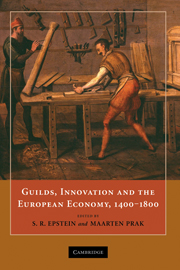Book contents
- Frontmatter
- Contents
- List of Contributors
- Acknowledgments
- Introduction: Guilds, Innovation, and the European Economy, 1400–1800
- 1 Craft Guilds, the Theory of the Firm, and Early Modern Proto-industry
- 2 Craft Guilds, Apprenticeship, and Technological Change in Pre-industrial Europe
- 3 Subcontracting in Guild-based Export Trades, Thirteenth–Eighteenth Centuries
- 4 Circulation of Skilled Labour in Late Medieval and Early Modern Central Europe
- 5 Painters, Guilds, and the Art Market during the Dutch Golden Age
- 6 Craft Guilds and Technological Change: The Engine Loom in the European Silk Ribbon Industry in the Seventeenth and Eighteenth Centuries
- 7 Guilds, Technology, and Economic Change in Early Modern Venice
- 8 Inventing in a World of Guilds: Silk Fabrics in Eighteenth-century Lyon
- 9 ‘Not to Hurt of Trade’: Guilds and Innovation in Horology and Precision Instrument Making
- 10 Reaching beyond the City Wall: London Guilds and National Regulation, 1500–1700
- 11 Guilds in Decline? London Livery Companies and the Rise of a Liberal Economy, 1600–1800
- Index
7 - Guilds, Technology, and Economic Change in Early Modern Venice
Published online by Cambridge University Press: 24 June 2009
- Frontmatter
- Contents
- List of Contributors
- Acknowledgments
- Introduction: Guilds, Innovation, and the European Economy, 1400–1800
- 1 Craft Guilds, the Theory of the Firm, and Early Modern Proto-industry
- 2 Craft Guilds, Apprenticeship, and Technological Change in Pre-industrial Europe
- 3 Subcontracting in Guild-based Export Trades, Thirteenth–Eighteenth Centuries
- 4 Circulation of Skilled Labour in Late Medieval and Early Modern Central Europe
- 5 Painters, Guilds, and the Art Market during the Dutch Golden Age
- 6 Craft Guilds and Technological Change: The Engine Loom in the European Silk Ribbon Industry in the Seventeenth and Eighteenth Centuries
- 7 Guilds, Technology, and Economic Change in Early Modern Venice
- 8 Inventing in a World of Guilds: Silk Fabrics in Eighteenth-century Lyon
- 9 ‘Not to Hurt of Trade’: Guilds and Innovation in Horology and Precision Instrument Making
- 10 Reaching beyond the City Wall: London Guilds and National Regulation, 1500–1700
- 11 Guilds in Decline? London Livery Companies and the Rise of a Liberal Economy, 1600–1800
- Index
Summary
Both the social sciences and popular sentiment tend to identify technological innovation with mechanisation, and oppose it to the protected environment of artisan craft guilds. Recent literature has begun to question this truism in favour of a more nuanced view of the attitudes of guilds towards technological change as part of broader debates on the relation between markets and institutions in pre-industrial Europe. Historians of early modern Italy have also increasingly questioned traditional, static views of craft guilds, but their revisionism has focussed less on the history of technology than on other aspects of guild life and structure. This chapter contributes new elements to this revisionist work by examining two crucial sectors of the early modern Venetian economy: silk and glass manufacturing. Both trades underwent profound changes between 1450 and 1800, largely in response to the rise of new, nearby and distant competitors. I focus on the seventeenth and eighteenth centuries, when international competition was especially fierce, and I address the question, not whether craft guilds as a rule favoured or opposed technological innovation, but why different guilds at different times selected some innovations and not others, and how they reshaped their production and market strategies more generally.
To approach the relationship between guilds and technology we need to deconstruct both terms: craft guilds differed in their labour composition and in their relations with other guilds, the market, and state authorities; technological change, on the other hand, included new tools, techniques, and production processes, but also new products and organisational forms.
- Type
- Chapter
- Information
- Guilds, Innovation and the European Economy, 1400–1800 , pp. 199 - 231Publisher: Cambridge University PressPrint publication year: 2008
- 7
- Cited by

